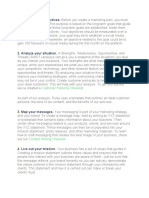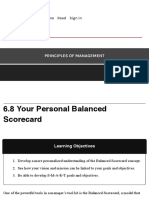Lesson 4 - Identify Goals and Objectives
Lesson 4 - Identify Goals and Objectives
Uploaded by
NathanCopyright:
Available Formats
Lesson 4 - Identify Goals and Objectives
Lesson 4 - Identify Goals and Objectives
Uploaded by
NathanOriginal Title
Copyright
Available Formats
Share this document
Did you find this document useful?
Is this content inappropriate?
Copyright:
Available Formats
Lesson 4 - Identify Goals and Objectives
Lesson 4 - Identify Goals and Objectives
Uploaded by
NathanCopyright:
Available Formats
Lesson 4 – Identify goals and objectives
LEARNING OBJECTIVES:
At the end of the lesson, the student must be able to:
• Identify how to make specific goals and objectives
• Create goals and objectives
INTRODUCTION:
This lesson deals with the study on how to make event goals and objectives
CONTENT:
Event Planning: Defining and identifying Event Goals and Objectives
Good event planning requires you to know up front what you’re trying to accomplish.
Otherwise, why have the event in the first place? Clearly-defined goals and objectives
help keep you on target throughout the event planning process. They also help you
avoid wasting resources, since every decision you make and every money you spend
relates back to your guiding purpose and helps you reach your goals and objectives
Starting to Define Event Goals & Objectives
Before you begin crafting your specific goals and objectives, spend some time
considering your purpose. Your purpose is the big-picture objective that should guide
all of your business decisions – these includes you MISSION and VISION.
Example of event organizer’s MISSION statement:
Our Mission
To serve the best to the clients with complete dedication and devotion working from
scratch to create the unique blue print for your entire event, making sure we have all
the details you want to incorporate into the program.
To deliver high-quality production and excellent services retain trust with clients over
the long term.
Our Vision
“TSAT Events” visualizes itself as the first choice of every person when it comes to the
planning of their big day.
Event goals are where you start to get more specific. The best goals support your
purpose. Your objectives create the roadmap to achieving your goals. Objectives are
more specific than goals, and they should be written in detail to define the narrow,
measurable, and tangible results you hope your event will produce.
Example:
Goal: Increase awareness of your brand/business.
Objective: There are lots of ways to measure awareness. One is to keep track of how
often people share or mention your event on social media. Keep tabs on posts from
the event by searching posts at your event location or by encouraging attendees to
use a hashtag for your event. Aim for a certain number of attendee posts at your next
event.
S.M.A.R.T. Objectives Are, Well…Smart
You may have heard of S.M.A.R.T. goals. For the purpose of event planning, we’re
going to talk about S.M.A.R.T. objectives instead of S.M.A.R.T. goals. Remember: Our
event goals are our reasons for hosting an event. Our objectives are how we get there.
Event objectives should be:
S – Specific: What outcome are you aiming for? What’s the deadline? A specific
objective could be “Booking events for the month of February”
M – Measurable: You should measure your objectives with numerical data whenever
possible. For example: “To book at least 20 events this February”
A – Achievable: You want to create objectives that are within reach. Be realistic:
“Book 20 event in one day” might not be achievable. Set objectives that motivate you
to succeed, but don’t set objectives that are impossible to achieve.
R – Relevant: The objective should relate back to your company’s goals. If it doesn’t,
it’s not worth pursuing.
T – Time-bound: Objectives should be time-bound, meaning they have a defined
start and end date so you can measure whether you met your goal during the allotted
time. Creating S.M.A.R.T. objectives that relate back to your organization’s purpose
and goals will keep you on track throughout your entire event planning process, from
venue selection to post-event survey questions.
Reference/s:
• CBLM IN EVENT MANAGEMENT SERVICES NC III
You might also like
- Event Planning ChecklistDocument22 pagesEvent Planning ChecklistAlexandra Dragomir100% (3)
- Brand ManagementDocument13 pagesBrand ManagementAMITaXWI100% (1)
- Lisa Rapuano Finding Your Way Along The Many Paths of ValueDocument29 pagesLisa Rapuano Finding Your Way Along The Many Paths of ValueValueWalk100% (2)
- Corridoio 8 Strade CompletoDocument177 pagesCorridoio 8 Strade Completocvijica635No ratings yet
- Information Sheet 2.1-1Document12 pagesInformation Sheet 2.1-1jonalynsaringan09072019No ratings yet
- Info. No. 2Document3 pagesInfo. No. 2Lorielyn VargasNo ratings yet
- Mice ConceptsDocument14 pagesMice ConceptsMaureen SubaNo ratings yet
- S-M-A-R-T Planning For Your EventsDocument12 pagesS-M-A-R-T Planning For Your EventsMia Persad-DouglasNo ratings yet
- GUIDE: How To Plan A Fundraiser: Students in OurDocument9 pagesGUIDE: How To Plan A Fundraiser: Students in OurJewelyn C. Espares-Ciocon100% (1)
- Retail Smart Goals: Written By: Marjory Pilley - Edited By: Michele Mcdonough - Updated: 3/8/2017Document3 pagesRetail Smart Goals: Written By: Marjory Pilley - Edited By: Michele Mcdonough - Updated: 3/8/2017julia_jayronwaldoNo ratings yet
- Event PlanningDocument9 pagesEvent Planninglakshya jainNo ratings yet
- How To Plan An Event: Table of ContentsDocument12 pagesHow To Plan An Event: Table of ContentsRedwan Afrid AvinNo ratings yet
- How To Set Smart GoalsDocument4 pagesHow To Set Smart GoalsMatheus TeodoroNo ratings yet
- Lesson2 Setting Business ObjectivesDocument5 pagesLesson2 Setting Business Objectivesbejaouimariem21No ratings yet
- Information Sheet No. 2.1-1 Develop An Event Concept: Identify Overall Event Objectives and ScopeDocument10 pagesInformation Sheet No. 2.1-1 Develop An Event Concept: Identify Overall Event Objectives and ScopeMarvin RoselNo ratings yet
- Tmo 351 PPT 5Document52 pagesTmo 351 PPT 5Abdul WajeedNo ratings yet
- How To Plan An Event: 10 Step Event Planning GuideDocument37 pagesHow To Plan An Event: 10 Step Event Planning GuideYovella Organizer100% (2)
- Module 2Document23 pagesModule 2Singhan SNo ratings yet
- Goals Vs ObjectivesDocument6 pagesGoals Vs Objectivesus100No ratings yet
- Goal Planning Worksheet For Inbound Marketing PDFDocument5 pagesGoal Planning Worksheet For Inbound Marketing PDFNguyen Phuong LinhNo ratings yet
- GSOTDocument15 pagesGSOTsaikumar selaNo ratings yet
- Unit 3 Event ManagementDocument5 pagesUnit 3 Event ManagementBijan GurungNo ratings yet
- All About Goal SettingDocument4 pagesAll About Goal Settingslashioguns15No ratings yet
- v1.1 ABC LTB LG Day 4Document32 pagesv1.1 ABC LTB LG Day 4sacascascNo ratings yet
- SMART Goals: How To Set Measurable, Achievable Goals: App Doctorate Big EventDocument3 pagesSMART Goals: How To Set Measurable, Achievable Goals: App Doctorate Big EventLuminita GiucaNo ratings yet
- Set Goals and Objectives.: Customer Persona ChecklistDocument3 pagesSet Goals and Objectives.: Customer Persona ChecklistMirtaz ShishirNo ratings yet
- S.M.A.R.T. Goal SettingDocument2 pagesS.M.A.R.T. Goal SettingPT Ngọc PhươngNo ratings yet
- Cognota Strategy Checklist & Cheat SheetDocument3 pagesCognota Strategy Checklist & Cheat SheetAgatha CassaNo ratings yet
- How Do You Know CompanyDocument5 pagesHow Do You Know CompanyajismandegarNo ratings yet
- Planning and Conceptualizing Social Advocacy For Developing An ICT Project DAY 1Document28 pagesPlanning and Conceptualizing Social Advocacy For Developing An ICT Project DAY 1Franzelle RaboyNo ratings yet
- Introduction To Event PlanningDocument31 pagesIntroduction To Event Planninggabriel100% (2)
- Setting Valuable ObjectivesDocument2 pagesSetting Valuable Objectivessee1tearNo ratings yet
- Smart Goals: Everything You Need to Know About Setting S.M.A.R.T GoalsFrom EverandSmart Goals: Everything You Need to Know About Setting S.M.A.R.T GoalsRating: 4 out of 5 stars4/5 (1)
- Downloadable CAREER ACTION PLAN Template 3Document3 pagesDownloadable CAREER ACTION PLAN Template 3Kojo Osei-MensahNo ratings yet
- The Taxonomy of Project DefinitionsDocument3 pagesThe Taxonomy of Project DefinitionsFurr Amiruddin TikingNo ratings yet
- Goal SettingDocument4 pagesGoal Settingjohnrichardjasmine100% (3)
- Gathering Information ReportDocument28 pagesGathering Information ReportLyca FelicisimoNo ratings yet
- Department of Education: Learning Activity SheetDocument4 pagesDepartment of Education: Learning Activity SheetViolet Tamayo CaadanNo ratings yet
- B. Building Goodwill Through Public RelationsDocument5 pagesB. Building Goodwill Through Public RelationsCamille Gene SolidumNo ratings yet
- SMART Goals and OKRsDocument9 pagesSMART Goals and OKRsLevanaNo ratings yet
- JaxuvutawiDocument2 pagesJaxuvutawiAyan BharNo ratings yet
- Goal Setting Time ManagementDocument23 pagesGoal Setting Time Managementsandyj18No ratings yet
- Personal Balanced Scorecard - Principles of ManagementDocument10 pagesPersonal Balanced Scorecard - Principles of ManagementEvangelos ThianiNo ratings yet
- How To Write SMART Goals v2Document13 pagesHow To Write SMART Goals v2ajay78_hiNo ratings yet
- SMART Goals:: A How To GuideDocument12 pagesSMART Goals:: A How To GuideShubhangi NigamNo ratings yet
- PMC 2 Module 2Document36 pagesPMC 2 Module 2gomezdestinie62No ratings yet
- Amna Develop Your Marketing Plan With Useful Tools AmnaDocument9 pagesAmna Develop Your Marketing Plan With Useful Tools AmnaTGS /// AyanNo ratings yet
- What Is SMART GoalDocument3 pagesWhat Is SMART GoalHp JarnoNo ratings yet
- Abm Concept PaperDocument30 pagesAbm Concept PaperiluvcheeseeeeNo ratings yet
- How To Write An Action Plan (WithDocument11 pagesHow To Write An Action Plan (WithJing MendiolaNo ratings yet
- 4.SMART Goals & Making Them MeaningfulDocument2 pages4.SMART Goals & Making Them MeaningfulreedashNo ratings yet
- Vision, Mission, Objectives ...Document5 pagesVision, Mission, Objectives ...elsha ayeleNo ratings yet
- Business Module L1 - L3Document25 pagesBusiness Module L1 - L3Aeyricsh LazaroNo ratings yet
- What Is A Professional Development Plan (PDP) ? 6 Steps To Create OneDocument10 pagesWhat Is A Professional Development Plan (PDP) ? 6 Steps To Create OneNoushin MivehchiNo ratings yet
- Planning and ConceptualizingDocument37 pagesPlanning and ConceptualizingyukiedimzNo ratings yet
- The Entrepreneur's Odyssey: How to Craft Your Unique Path to SuccessFrom EverandThe Entrepreneur's Odyssey: How to Craft Your Unique Path to SuccessNo ratings yet
- A Guide To Setting GoalsDocument2 pagesA Guide To Setting Goalsapi-645247919No ratings yet
- Objectives and Goals of BusinessDocument4 pagesObjectives and Goals of BusinessKhalid de CancNo ratings yet
- Lesson Based LabelsDocument2 pagesLesson Based LabelsNathanNo ratings yet
- Week and Lesson Based LabelsDocument2 pagesWeek and Lesson Based LabelsNathanNo ratings yet
- 1stQ-Week5Document3 pages1stQ-Week5NathanNo ratings yet
- DLL Hope W7Document3 pagesDLL Hope W7NathanNo ratings yet
- DLL Hope W3Document2 pagesDLL Hope W3NathanNo ratings yet
- Week 2 OmtrmDocument3 pagesWeek 2 OmtrmNathanNo ratings yet
- Week 5 OmtrmDocument3 pagesWeek 5 OmtrmNathanNo ratings yet
- Week 1 OmtrmDocument4 pagesWeek 1 OmtrmNathanNo ratings yet
- Chapter 7Document15 pagesChapter 7NathanNo ratings yet
- Chapter 6Document14 pagesChapter 6NathanNo ratings yet
- Chapter 2Document14 pagesChapter 2NathanNo ratings yet
- Week 1 - Lesson 1 Fundamentals in Food Service OpDocument4 pagesWeek 1 - Lesson 1 Fundamentals in Food Service OpNathanNo ratings yet
- Chapter 1 Lesson 1Document10 pagesChapter 1 Lesson 1NathanNo ratings yet
- Lesson 5 - Business Etiquette Part 2: Learning ObjectivesDocument4 pagesLesson 5 - Business Etiquette Part 2: Learning ObjectivesNathanNo ratings yet
- Week 3 - Fundamentals in Food Service OpDocument3 pagesWeek 3 - Fundamentals in Food Service OpNathanNo ratings yet
- Lesson 6 - Techniques in Professional Development Phase I: Learning ObjectivesDocument4 pagesLesson 6 - Techniques in Professional Development Phase I: Learning ObjectivesNathanNo ratings yet
- Lesson 8 - Planning For Career Development: Learning ObjectivesDocument3 pagesLesson 8 - Planning For Career Development: Learning ObjectivesNathanNo ratings yet
- Lesson 5 - Business Etiquette Part 1: Learning ObjectivesDocument4 pagesLesson 5 - Business Etiquette Part 1: Learning ObjectivesNathanNo ratings yet
- Global Perspective of IhrmDocument11 pagesGlobal Perspective of IhrmAnoop SainiNo ratings yet
- Labour Market ReformsDocument9 pagesLabour Market ReformsGauri Rao100% (1)
- ACCA F9 Revision Question Bank-49-51Document3 pagesACCA F9 Revision Question Bank-49-51rbaamba100% (1)
- Pay PalDocument18 pagesPay PalYogesh YadavNo ratings yet
- Principle of Marketing-Research MarketDocument21 pagesPrinciple of Marketing-Research MarketAMOS WASIKENo ratings yet
- BSM Unit 5Document7 pagesBSM Unit 5koketsomalele00No ratings yet
- List of Top HR Project Topics For MBADocument5 pagesList of Top HR Project Topics For MBASaran RajNo ratings yet
- CTT EXAMINATION REVIEWER - Compilation of MCQs (RJ Answers)Document21 pagesCTT EXAMINATION REVIEWER - Compilation of MCQs (RJ Answers)James RelletaNo ratings yet
- Big Earn-3Document15 pagesBig Earn-3Nasim AktarNo ratings yet
- 12th Ratio Full NotesDocument7 pages12th Ratio Full NotesRoyal Dancer's CityNo ratings yet
- Hotel Receptionist/Front of House Job DescriptionDocument2 pagesHotel Receptionist/Front of House Job DescriptionAnonymous ecxrmUcCNo ratings yet
- Bank of Credit and Commerce InternationalDocument9 pagesBank of Credit and Commerce InternationalMd. FaysalNo ratings yet
- Dax SukhrajDocument11 pagesDax SukhrajkeybasesukhrajNo ratings yet
- Standard Costing and Variance AnalysisDocument12 pagesStandard Costing and Variance Analysistengku marianaNo ratings yet
- CIS Chapter 1Document2 pagesCIS Chapter 1Michelle AnnNo ratings yet
- Master ListDocument178 pagesMaster Listshreekumar_scdlNo ratings yet
- Stat253 Student Final ListDocument10 pagesStat253 Student Final Listiraverdique700No ratings yet
- FedxDocument21 pagesFedxVingdeswaran SubramaniyanNo ratings yet
- International Economics 8th Edition Appleyard Solutions ManualDocument9 pagesInternational Economics 8th Edition Appleyard Solutions Manuala159411610No ratings yet
- Unit 1-1Document46 pagesUnit 1-1ashutosh kankaneNo ratings yet
- Audit of ExpensesDocument3 pagesAudit of ExpensesIG RaheesNo ratings yet
- The Competitive Strategies of Red RibbonDocument2 pagesThe Competitive Strategies of Red RibbonMark Leo Opo RetuertoNo ratings yet
- Parity PricingDocument3 pagesParity PricingUshba SabihaNo ratings yet
- Depreciation Question TextbookDocument28 pagesDepreciation Question TextbookShuayb KhanNo ratings yet
- CV .Om. PKDocument2 pagesCV .Om. PKGun AceNo ratings yet
- Statement of Cash FlowDocument19 pagesStatement of Cash FlowSHARMAINE JOY FULGARNo ratings yet
- Employee Behavior and Motivation: Instructor Lecture PowerpointsDocument26 pagesEmployee Behavior and Motivation: Instructor Lecture PowerpointsAugie HerdaniNo ratings yet











































































































